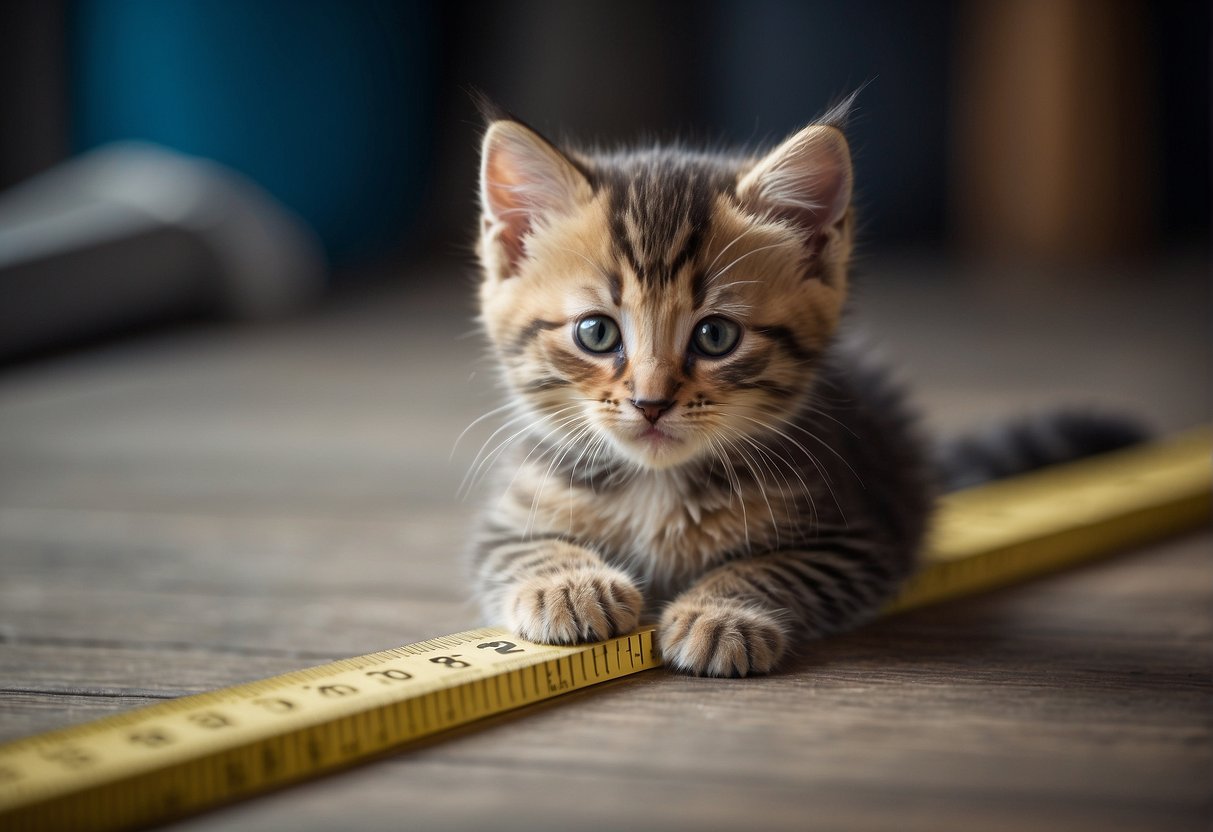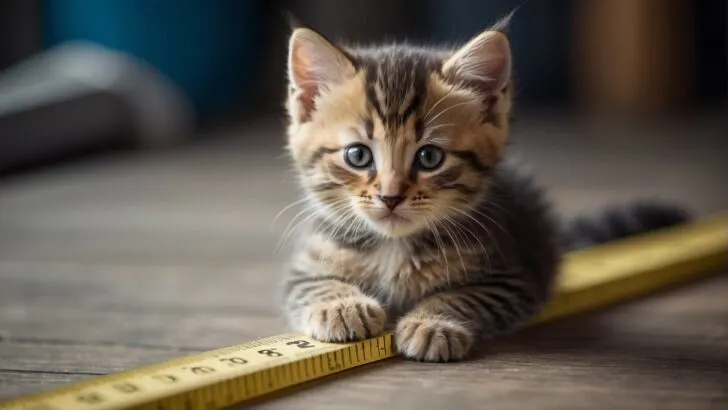Many cat owners ponder when their feline companions will reach their full size. Typically, cats stop growing by the time they are 18 months old. From my experience, watching kittens grow can be quite astonishing; they start out so tiny and, within a year, they’re leaping and bounding as full-grown adults.
For instance, one of mine was just a palm-sized furball at two months, but by the one-year mark, he was nearly at his adult weight and size.

The growth of cats is not merely defined by age but also by the life stage they are in, which includes stages such as kitten, junior, prime, mature, senior, and geriatric.
Your kitten, up to about 6 months old, will experience rapid growth, visibly getting bigger almost daily. After this period, growth slows down significantly, and it’s during the junior stage—spanning from 7 months to 2 years—that most cats will fill out and reach their physical maturity, especially noticeable in their musculature and stature.
The breed can play a significant role in how large they’ll eventually get and when their growth will taper off. Larger breeds, like Maine Coons, can continue to grow up to 4 or 5 years old, while smaller breeds tend to reach maturity sooner. So, you’ll want to take into consideration your cat’s specific breed, as it can vary the timeline of when they’ll stop growing.
Factors Affecting Growth in Cats

Your cats growth can be influenced by a variety of factors, ranging from breed characteristics to the quality of their diet.
Breed-Specific Growth Patterns
Each cat breed has unique growth timelines and characteristics. For example, a Maine Coon may continue growing until they are 3-5 years old, much longer than most domestic breeds.
Conversely, a Munchkin cat, known for its short stature, reaches its full size much earlier. Other breeds like the Siamese, Ragdoll, and Bengal fall somewhere in between, often reaching full growth between one and two years of age.
The Role of Genetics and Sex
The genetics of your cat play a pivotal role in determining its ultimate size and weight. Save for breed-specific traits, sexual maturity can affect growth too.
Generally, male cats often grow larger and may stop growing later in life compared to females. Speaking of which, neutering or spaying a kitten can also influence its growth, often leading to a longer growth period before they reach what’s considered full grown.
Impact of Nutrition and Diet
What you feed your kitten can greatly impact their growth. High-quality kitten food rich in protein, vitamins, and a well-balanced diet are key for proper development. As they transition to adult cat food, it’s essential to adjust their diet to prevent overfeeding.
Adequate nutrition ensures they grow to a healthy weight without becoming overweight, which can affect their overall health and lifespan.
Growth Milestones for Kittens and Cats
In the journey from tiny furballs to graceful felines, your kittens go through several growth milestones that reflect their physical and behavioral development. Let’s explore these changes from fluffy beginnings to the sleek maturity of cat adulthood.
From Kittens to Adolescence
When your kitten first arrives, they are often a bundle of energy, with significant growth and development ahead.
Weight and Physical Development:
- Birth-2 Weeks:
- Average weight at birth: Approximately 50 grams (2 ounces).
- They are blind and deaf, with eyes and ears opening around the second week.
- 3 Weeks:
- Start developing teeth and may begin to explore more.
- Beginning of more deliberate movements and exercise, which is crucial for muscle development.
- 6 Weeks:
- Weight gain is steady; they could weigh around 500 grams to 700 grams (1 to 1.5 pounds).
- Activity levels increase – expect little bursts of kitten energy!
- 3 Months:
- They can reach 1 kg (2.2 pounds) and will start showing more coordinated exercise behaviors.
- Social and play behaviors emerge; a vital time for learning limits and social cues.
Behavioral Changes:
- Play is essential for your kitten’s development; it’s both a learning process and an exercise.
- Interaction with humans and other pets helps them develop proper social skills.
Reaching Adulthood and Maturity
As your kittens enter adulthood, you’ll notice the pace of their growth starting to slow.
Weight and Physical Growth:
- 6 Months:
- Kittens often weigh over 2 kg (4.4 pounds) and have a significant decrease in growth rate.
- This stage marks the transition towards adulthood, so their dietary needs might change.
- 1 Year:
- They typically reach their full size, averaging around 3 to 5 kg (6.6 to 11 pounds), although specific breeds can vary.
- By now, most kittens have fully developed adult teeth.
Behavioral and Physical Maturation:
- Exercise remains vital as your cat enters its prime, but the frenetic activity of kittenhood gives way to more calculated movements.
- In this phase, your cat’s personality really takes shape; they’re more sure-footed and assured.
Each cat matures at their own unique pace, so these milestones provide general guidelines rather than strict timelines.
Understanding Weight and Size Variations
Cats, much like their human companions, come in a variety of shapes and sizes, each influenced by a range of factors.
Adult Cat Size and Healthy Weight Ranges
When your furry friend reaches adulthood, typically between 1 and 2 years of age, they’re considered full grown. However, what qualifies as a healthy size and weight for your cat depends on several factors, including breed and overall body composition.
On average, a domestic cat weighs around 7.9 – 9.9 pounds (3.6 – 4.5 kg). Large breeds like Maine Coons or Ragdolls, can weigh more, often ranging from 13 to 22 pounds (5.9 – 10 kg) upon reaching maturity. It’s crucial to monitor their weight closely because obesity in cats is associated with health issues, just as it is in humans.
- Healthy Weight Ranges:
- Small Adult Cats: 5 – 8 lbs (2.3 – 3.6 kg)
- Average Adult Cats: 7.9 – 9.9 lbs (3.6 – 4.5 kg)
- Large Breeds: 13 – 22 lbs (5.9 – 10 kg)
Factors Contributing to Weight and Size Differences
A mix of genetics, diet, exercise, and sex influences your cat’s ultimate weight and size. Take, for instance, metabolism; every cat has a unique metabolic rate that plays a direct role in their ability to gain, lose or maintain weight.
Similarly, daily exercise is vital in preventing obesity and promoting a healthy, active lifestyle for your cat.
- Contributing Factors:
- Genetics: Your cat’s breed largely determines their size potential.
- Nutritional Intake: What and how much you feed your cat affects their weight.
- Exercise: Regular play helps maintain healthy weight and muscle mass.
- Sex: Male cats often grow larger than their female counterparts.
- Metabolism: Like in people, a cat’s metabolism influences their size.
Recognizing that each cat’s growth is unique, paying attention to these factors helps you maintain their health. If your cat seems smaller than average or is growing at a slower rate, a checkup might be in order.

My name is James, and welcome to FAQCats!
Along with our team of cat owners, expert pet enthusiasts, and pet professionals, we aim to write engaging helpful, engaging content about cats. At FAQCats we strive to provide content that’s accurate and fun to read. Our team writes about everything related to cats; even the most complex of topics. Through extensive research and caring for our own fur-pals, we’re able to provide something cat owners worldwide will love. Have a look around, and leave us feedback anytime!

